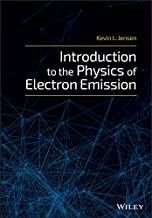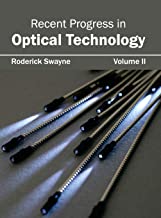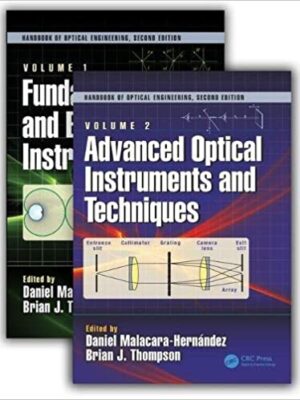Introduction to the Physics of Electron Emmission
Original price was: ₹11,232.60.₹8,986.08Current price is: ₹8,986.08.
ISBN: 9781119051893
Author/Editor: Jensen
Publisher: John Wiley
Year: 2017
1 in stock (can be backordered)
Description
A practical, in-depth description of the physics behind electron emission physics and its usage in science and technology
Electron emission is both a fundamental phenomenon and an enabling component that lies at the very heart of modern science and technology. Written by a recognized authority in the field, with expertise in both electron emission physics and electron beam physics, An Introduction to Electron Emission provides an in-depth look at the physics behind thermal, field, photo, and secondary electron emission mechanisms, how that physics affects the beams that result through space charge and emittance growth, and explores the physics behind their utilization in an array of applications.
The book addresses mathematical and numerical methods underlying electron emission, describing where the equations originated, how they are related, and how they may be correctly used to model actual sources for devices using electron beams. Writing for the beam physics and solid state communities, the author explores applications of electron emission methodology to solid state, statistical, and quantum mechanical ideas and concepts related to simulations of electron beams to condensed matter, solid state and fabrication communities.
Provides an extensive description of the physics behind four electron emission mechanisms-field, photo, and secondary, and how that physics relates to factors such as space charge and emittance that affect electron beams.
Introduces readers to mathematical and numerical methods, their origins, and how they may be correctly used to model actual sources for devices using electron beams
Demonstrates applications of electron methodology as well as quantum mechanical concepts related to simulations of electron beams to solid state design and manufacture
Designed to function as both a graduate-level text and a reference for research professionals
Introduction to the Physics of Electron Emission is a valuable learning tool for postgraduates studying quantum mechanics, statistical mechanics, solid state physics, electron transport, and beam physics. It is also an indispensable resource for academic researchers and professionals who use electron sources, model electron emission, develop cathode technologies, or utilize electron beams.
Additional information
| Weight | 1.97 kg |
|---|
Product Properties
| Year of Publication | 2017 |
|---|---|
| Table of Contents | Acknowledgements 2 Part I Foundations 5 1 Prelude 7 2 Units and Evaluation 11 2.1 Numerical Accuracy 11 2.2 Atomic-sized Units 13 2.3 Units Based on Emission 18 3 Pre-Quantum Models 21 3.1 Discovery of Electron Emission 21 3.2 The Drude Model and Maxwell-Boltzmann Statistics 22 3.3 The Challenge of Photoemission 31 4 Statistics 37 4.1 Distinguishable Particles 37 4.2 Probability and States 43 4.3 Probability and Entropy 45 4.4 Combinatorics and Products of Probability 50 5 Maxwell-Boltzmann Distribution 55 5.1 Classical Phase Space 55 5.2 Most Probable Distribution 59 5.3 Energy and Entropy 62 5.4 The Gibbs Paradox 63 5.5 Ideal Gas in a Potential Gradient 65 5.6 The Grand Partition Function 67 5.7 A Nascent Model of Electron Emission 69 6 Quantum Distributions 73 6.1 Bose-Einstein Distribution 73 6.2 Fermi-Dirac Distribution 74 6.3 The Riemann Zeta Function 75 6.4 Chemical Potential 78 6.5 Classical to Quantum Statistics 84 6.6 Electrons and White Dwarf Stars 85 7 A Box of Electrons 91 7.1 Scattering 91 7.2 From Classical to Quantum Mechanics 92 7.3 Moments and Distributions 94 7.4 Boltzmann s Transport Equation 96 8 Quantum Mechanics Methods 107 8.1 A Simple Model: The Prisoner s Dilemma 107 8.2 Matrices and Wave Functions 115 9 Quintessential Problems 133 9.1 The Hydrogen Atom 134 9.2 Transport Past Barriers 151 9.3 The Harmonic Oscillator 162 Part II The Canonical Equations 175 10 A Brief History 177 10.1 Thermal Emission 178 10.2 Field Emission 180 10.3 Photoemission 181 10.4 Secondary Emission 181 10.5 Space Charge Limited Emission 182 10.6 Resources and Further Reading 183 11 Anatomy of Current Density 187 11.1 Supply Function 188 11.2 Gamow Factor 189 11.3 Image Charge Potential 194 12 Richardson-Laue-Dushman Equation 197 12.1 Approximations 197 12.2 Analysis of Thermal Emission Data 199 13 Fowler-Nordheim Equation 201 13.1 Triangular Barrier Approximation 203 13.2 Image Charge Approximation 205 13.3 Analysis of Field Emission Data 211 13.4 The Millikan-Lauritsen Hypothesis 213 14 Fowler-Dubridge Equation 217 14.1 Approximations 217 14.2 Analysis of Photoemission Data 221 15 Baroody Equation 225 15.1 Approximations 225 15.2 Analysis of Secondary Emission Data 232 15.3 Subsequent Approximations 234 16 Child-Langmuir Law 237 16.1 Constant Density Approximation 238 16.2 Constant Current Approximation 241 16.3 Transit Time Approximation 245 17 A General Thermal-Field-Photoemission Equation 251 17.1 Experimental Thermal-Field Energy Distributions 253 17.2 Theoretical Thermal-Field Energy Distributions 255 17.3 The N(n; s; u) Function 264 17.4 Brute Force Evaluation 275 17.5 A Computationally Kind Model 282 17.6 General Thermal Field Emission Code 288 Part III Exact Tunneling and Transmission Evaluation 297 18 Simple Barriers 299 18.1 Rectangular Barrier 300 18.2 Triangular Barrier - General Method 306 18.3 Triangular Barrier - Numerical 318 19 Transfer Matrix Approach 325 19.1 Plane Wave Transfer Matrix 326 19.2 Airy Function Transfer Matrix 335 20 Ion Enhanced Emission and Breakdown 353 20.1 Paschen s Curve 353 20.2 Modified Paschen s Curve 357 20.3 Ions and the Emission Barrier 360 Part IV The Complexity of Materials 367 21 Metals 369 21.1 Density of States, Again 370 21.2 Spheres in d Dimensions 372 21.3 The Kronig Penny Model 375 21.4 Atomic Orbitals 381 21.5 Electronegativity 383 21.6 Sinusoidal Potential and Band Gap 388 21.7 Ion Potentials and Screening 391 22 Semiconductors 397 22.1 Resistivity 397 22.2 Electrons and Holes 400 22.3 Band Gap and Temperature 403 22.4 Doping of Semiconductors 406 22.5 Semiconductor Image Charge Potential 411 22.6 Dielectric Constant and Screening 414 23 Effective Mass 417 23.1 Dispersion Relations 417 23.2 The k - p Method 420 23.3 Hyperbolic Relations 424 23.4 The Alpha Semiconductor Model 428 23.5 Current and Effective Mass 433 24 Interfaces 435 24.1 Metal-Insulator-Metal Current Density 435 24.2 Band Bending 445 24.3 Accumulation Layers 447 24.4 Depletion Layers 458 24.5 Modifications Due to Non-Linear Potential Barriers 466 25 Contacts, Conduction, and Current 471 25.1 Zener Breakdown 471 25.2 Poole-Frenkel Transport 472 25.3 Tunneling Conduction 477 25.4 Resonant Tunneling in Field Emission 483 26 Electron Density Near Barriers 489 26.1 An Infinite Barrier 489 26.2 Two Infinite Barriers 493 26.3 A Triangular Well 495 26.4 Density and Dipole Component 499 27 Many Body Effects and Image Charge 507 27.1 Kinetic Energy 508 27.2 Exchange Energy 509 27.3 Correlation Term 511 27.4 Core Term 512 27.5 Exchange-Correlation and a Barrier Model 518 28 An Analytic Image Charge Potential 523 28.1 Work Function and Temperature 523 28.2 Work Function and Field 526 28.3 Changes to Current Density 528 Part V Application Physics 531 29 Dispenser Cathodes 533 29.1 Miram Curves and the Longo Equation 534 29.2 Diffusion of Coatings 539 29.3 Evaporation of Coatings 564 29.4 Knudsen Flow Through Pores 568 29.5 Lifetime of a Sintered Wire Controlled Porosity Dispenser Cathode 577 30 Field Emitters 581 30.1 Field Enhancement 582 30.2 Hemispheres and Notional Emission Area 586 30.3 Point Charge Model 590 30.4 Schottky s Conjecture 594 30.5 Assessment of the Tip Current Models 601 30.6 Line Charge Models 603 30.7 Prolate Spheroidal Representation 608 30.8 A Hybrid Analytic-Numerical Model 616 30.9 Shielding 627 30.10 Statistical Variation 633 31 Photoemitters 643 31.1 Scattering Consequences 648 31.2 Basic Theory 650 31.3 Three Step Model 652 31.4 Moments Model 656 31.5 Reflectivity and Penetration Factors 664 31.6 Lorentz-Drude Model of the Dielectric Constant 667 31.7 Scattering Contributions 678 31.8 Low Work Function Coatings 695 31.9 Quantum Efficiency of a Cesiated Surface 706 32 Secondary Emission Cathodes 709 32.1 Diamond Amplifier Concept 710 32.2 Monte Carlo Methods 720 32.3 Relaxation Time 729 32.4 Monte Carlo and Diamond Amplifier Response Time 753 33 Electron Beam Physics 765 33.1 Electron Orbits and Cathode Area 767 33.2 Beam Envelope Equation 769 33.3 Emittance for Flat and Uniform Surfaces 776 33.4 Emittance for A Bump 796 33.5 Emittance and Realistic Surfaces 823 Part VI Appendicies 827 A Summation, Integration, and Differentiation 829 A.1 Series 829 A.2 Integration 830 A.3 Differentiation 840 A.4 Numerical Solution of an Ordinary Differential Equation 847 B Functions 851 B.1 Trigonometric Functions 851 B.2 Gamma Function 851 B.3 Riemann Zeta Function 852 B.4 Error Function 853 B.5 Legendre Polynomials 854 B.6 Airy Functions 855 B.7 Lorentzian Functions 858 C Algorithms 861 C.1 Permutation Algorithm 861 C.2 Birthday Algorithm 862 C.3 Least Squares Fitting of Data 863 C.4 Monty Hall Algorithm 867 C.5 Wave Function and Density Algorithm 868 C.6 Hydrogen Atom Algorithms 870 C.7 Root Finding Methods 873 C.8 Thermal-Field Algorithm 877 C.9 Gamow Factor Algorithm 879 C.10 Triangular Barrier D(E) 880 C.11 Evaluation of Hc(u) 881 C.12 Transfer Matrix Algorithm 883 C.13 Semiconductors and Doping Density 890 C.14 Band Bending: Accumulation Layer 892 C.15 Simple ODE Solvers 893 C.16 Current through a Metal-Insulator-Metal diode 897 C.17 Field Emission From Semiconductors 898 C.18 Roots of the Quadratic Image Charge Barrier 901 C.19 Zeros of the Airy Function 902 C.20 Atomic Sphere Radius rs 904 C.21 Sodium Exchange-Correlation Potential 906 C.22 Field Dependent Work Function 907 C.23 Digitizing an Image file 907 C.24 Lattice Gas Algorithm 909 C.25 Evaluation of the Point Charge Model Functions 912 C.26 Modeling of Field Emitter I(V ) Data 913 C.27 Modeling a Log-Normal Distribution of Field Emitters 915 C.28 Simple Shell and Sphere Algorithm 919 C.29 Gyftopoulos-Levine Work function Algorithm 921 C.30 Poisson Distributions 924 C.31 Electron-Electron Relaxation Time 927 C.32 Resistivity and the Debye Temperature 928 C.33 Orbits in a Magnetic Field 931 C.34 Trajectory of a Harmonic Oscillator 935 C.35 Trajectories for Emission from a Hemisphere 936 C.36 Monte Carlo and Integration 938 Index |
| Author | Jensen |
| ISBN/ISSN | 9781119051893 |
| Binding | Hardback |
| Edition | 1 |
| Publisher | John Wiley |
You must be logged in to post a review.






Reviews
There are no reviews yet.